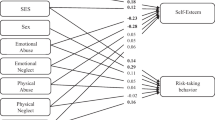Abstract
Nearly one-third (28.4 %) of adolescents experience some form of physical assault in the home. A survey of 176 adolescents documents optimistic bias; adolescents believe they are less likely than others to become victims of family violence. Elements of the Health Belief Model, perceived susceptibility and perceived severity, predicted optimistic bias. The study also considers the impact vicarious experience through the media on adolescent risk perception.
Similar content being viewed by others
References
Baker, F., Dye, J., Denniston, M., & Ainsworth, S. (2001). Risk perception and cigar smoking behavior. American Journal of Health Behavior, 25(2), 106–114.
Brown, S., & Morley, A. (2007). Risk perception, fuzzy representations and comparative optimism. British Journal of Psychology, 98, 575–587.
Campbell, J., Greenauer, N., Macaluso, K., & End, C. (2007). Unrealistic optimism in internet events. Computers in Human Behavior, 23, 1273–1284.
Campo, S., Poulos, G., & Sipple, J. (2005). Prevalence and profiling: hazing among college students and points of intervention. American Journal of Health Behavior, 29(2), 137–149.
Carlson, A., Campbell, J., Garza, M., Campo, P., Dienemann, J., Kub, J., Jones, A., & Lloyd, D. (2006). Domestic violence in the military: Women’s policy preferences and beliefs concerning routine screening and mandatory reporting. Military Medicine, 171(8), 729–735.
Chapin, J. (2008). Youth perceptions of their school violence risks. Adolescence, 43(171), 461–471.
Chapin, J. (2006). Optimistic bias on the front line: emergency medical personnel and domestic violence screening. International Journal of Interdisciplinary Social Sciences, 1, 183–187.
Clarke, V., Lovegrove, H., Williams, A., & Machperson, M. (2000). Unrealistic optimism and the health belief model. Journal of Behavioral Medicine, 23(4), 367–376.
Cornelius, T., Sullivan, K., Wyngarden, N., & Milliken, J. (2009). Participation in prevention programs for dating violence: beliefs about relationship violence and intention to participate. Journal of Interpersonal Violence, 24(6), 1057–1078.
Hussey, J., Chang, J., & Kotch, J. (2006). Child maltreatment in the united states: prevalence, risk factors, and adolescent health consequences. Pediatrics, 118(3), 933–942.
Lin, P., Simoni, J., & Zemon, V. (2005). The health belief model, sexual behaviors, and HIV risk among Taiwanese immigrants. AIDS Education and Prevention, 17(5), 469–483.
Luo, J., & Isaacowitz, D. (2007). How optimists face skin cancer information: risk assessment, attention, memory and behavior. Psychology and Health, 22(8), 963–984.
Prentice, K., Gold, J., & Carpenter, W. (2005). Optimistic bias in the perception of personal risk patterns in schizophrenia. The American Journal of Psychiatry, 162(3), 507–512.
Tanner, R. & Carlson, K. (2009). Unrealistically optimistic consumers: A selective hypothesis testing account for optimism in predictions of future behavior. Journal of Consumer Research, 35. doi:10.1086/593690.
Quinn, G., Bell-Ellison, B., Loomis, W., & Tucci, M. (2007). Adolescent perceptions of violence: formative research findings from a social marketing campaign to reduce violence among middle school youth. Public Health, 121(5), 357–366.
Uglem, S., Frolich, W., Stea, T., & Wandel, M. (2007). Preferences and perceptions of personal vegetable consumption: a study among young men in the Norwegian national guard. International Journal of Food Sciences and Nutrition, 59(4), 279–290.
Van de Ven, P., Rawstorne, P., Nakamura, T., Crawford, J., & Kippax, S. (2002). HIV treatments optimism is associated with unprotected anal intercourse with regular and with casual partners among Australian gay and homosexually active men. International Journal of STD and AIDS, 13(3), 181–185.
Walker, E., Caban, A., Schecter, C., Basch, C., Blanco, E., DeWitt, T., Kalten, M., Mera, M. & Mojica, G. (2007). Measuring comparative risk perceptions in an urban minority population. The risk perception survey for diabetes, 103–110.
Weinstein, N. (1980). Unrealistic optimism about future life events. Journal of Personality and Social Psychology, 39, 806–460.
White, M., Eiser, J., Harris, P., & Pahl, S. (2007). Who reaps the benefits, who bears the risks? Comparative optimism, comparative utility and regulatory preferences for mobile phone technology. Risk Analysis, 27(3), 1539–6924.
Acknowledgments
The authors wish to acknowledge the contributions of the staff of Crisis Center North to this project. The authors also wish to thank the editors and reviewers of this journal on feedback throughout the revision process.
Author information
Authors and Affiliations
Corresponding author
Rights and permissions
About this article
Cite this article
Chapin, J., Coleman, G. Adolescents’ Perceptions of Family Violence Risks. J Fam Viol 29, 757–761 (2014). https://doi.org/10.1007/s10896-014-9634-1
Published:
Issue Date:
DOI: https://doi.org/10.1007/s10896-014-9634-1



